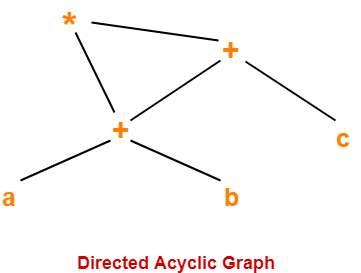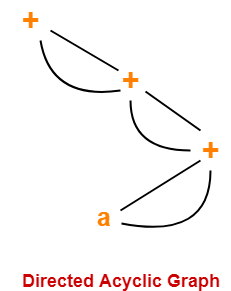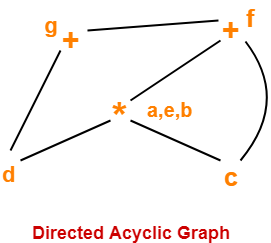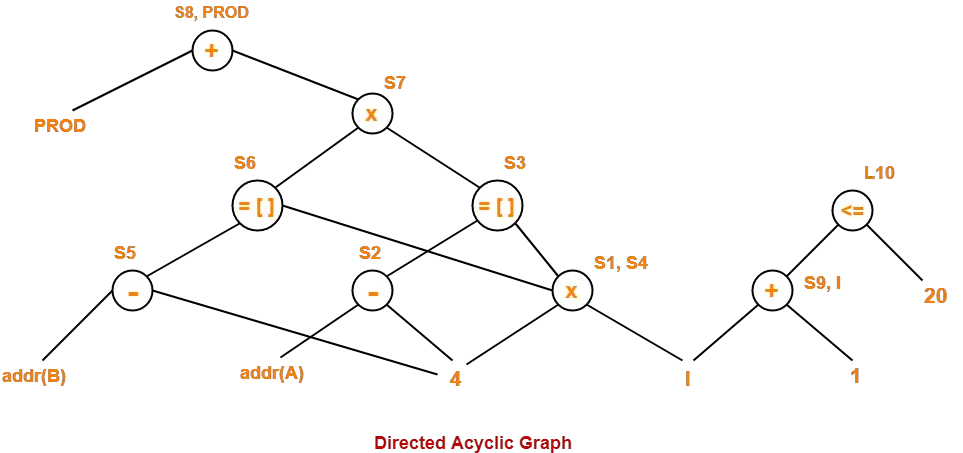Directed Acyclic Graph-
| Directed Acyclic Graph (DAG) is a special kind of Abstract Syntax Tree. |
- Each node of it contains a unique value.
- It does not contain any cycles in it, hence called Acyclic.
Optimization Of Basic Blocks-
| DAG is a very useful data structure for implementing transformations on Basic Blocks. |
- A DAG is constructed for optimizing the basic block.
- A DAG is usually constructed using Three Address Code.
- Transformations such as dead code elimination and common sub expression elimination are then applied.
Properties-
- Reachability relation forms a partial order in DAGs.
- Both transitive closure & transitive reduction are uniquely defined for DAGs.
- Topological Orderings are defined for DAGs.
Applications-
DAGs are used for the following purposes-
- To determine the expressions which have been computed more than once (called common sub-expressions).
- To determine the names whose computation has been done outside the block but used inside the block.
- To determine the statements of the block whose computed value can be made available outside the block.
- To simplify the list of Quadruples by not executing the assignment instructions x:=y unless they are necessary and eliminating the common sub-expressions.
Construction of DAGs-
Following rules are used for the construction of DAGs-
Rule-01:
In a DAG,
- Interior nodes always represent the operators.
- Exterior nodes (leaf nodes) always represent the names, identifiers or constants.
Rule-02:
While constructing a DAG,
- A check is made to find if there exists any node with the same value.
- A new node is created only when there does not exist any node with the same value.
- This action helps in detecting the common sub-expressions and avoiding the re-computation of the same.
Rule-03:
The assignment instructions of the form x:=y are not performed unless they are necessary.
Also Read- Code Optimization
PRACTICE PROBLEMS BASED ON DIRECTED ACYCLIC GRAPHS-
Problem-01:
Consider the following expression and construct a DAG for it-
( a + b ) x ( a + b + c )
Solution-
Three Address Code for the given expression is-
T1 = a + b
T2 = T1 + c
T3 = T1 x T2
Now, Directed Acyclic Graph is-

NOTE
From the constructed DAG, we observe-
This illustrates how the construction scheme of a DAG identifies the common sub-expression and helps in eliminating its re-computation later. |
Problem-02:
Consider the following expression and construct a DAG for it-
( ( ( a + a ) + ( a + a ) ) + ( ( a + a ) + ( a + a ) ) )
Solution-
Directed Acyclic Graph for the given expression is-

Problem-03:
Consider the following block and construct a DAG for it-
(1) a = b x c
(2) d = b
(3) e = d x c
(4) b = e
(5) f = b + c
(6) g = f + d
Solution-
Directed Acyclic Graph for the given block is-

Problem-04:
Optimize the block in the Problem-03.
Solution-
Step-01:
Firstly, construct a DAG for the given block (already done above).
Step-02:
Now, the optimized block can be generated by traversing the DAG.
- The common sub-expression e = d x c which is actually b x c (since d = b) is eliminated.
- The dead code b = e is eliminated.
The optimized block is-
(1) a = b x c
(2) d = b
(3) f = a + c
(4) g = f + d
Problem-05:
Consider the following basic block-
B10:
S1 = 4 x I
S2 = addr(A) – 4
S3 = S2[S1]
S4 = 4 x I
S5 = addr(B) – 4
S6 = S5[S4]
S7 = S3 x S6
S8 = PROD + S7
PROD = S8
S9 = I + 1
I = S9
If I <= 20 goto L10
- Draw a directed acyclic graph and identify local common sub-expressions.
- After eliminating the common sub-expressions, re-write the basic block.
Solution-
Directed Acyclic Graph for the given basic block is-

In this code fragment,
- 4 x I is a common sub-expression. Hence, we can eliminate because S1 = S4.
- We can optimize S8 = PROD + S7 and PROD = S8 as PROD = PROD + S7.
- We can optimize S9 = I + 1 and I = S9 as I = I + 1.
After eliminating S4, S8 and S9, we get the following basic block-
B10:
S1 = 4 x I
S2 = addr(A) – 4
S3 = S2[S1]
S5 = addr(B) – 4
S6 = S5[S1]
S7 = S3 x S6
PROD = PROD + S7
I = I + 1
If I <= 20 goto L10
To gain better understanding about Directed Acyclic Graphs,
Download Handwritten Notes Here-
Next Article- Misc Problems On Directed Acyclic Graphs
Get more notes and other study material of Compiler Design.
Watch video lectures by visiting our YouTube channel LearnVidFun.


